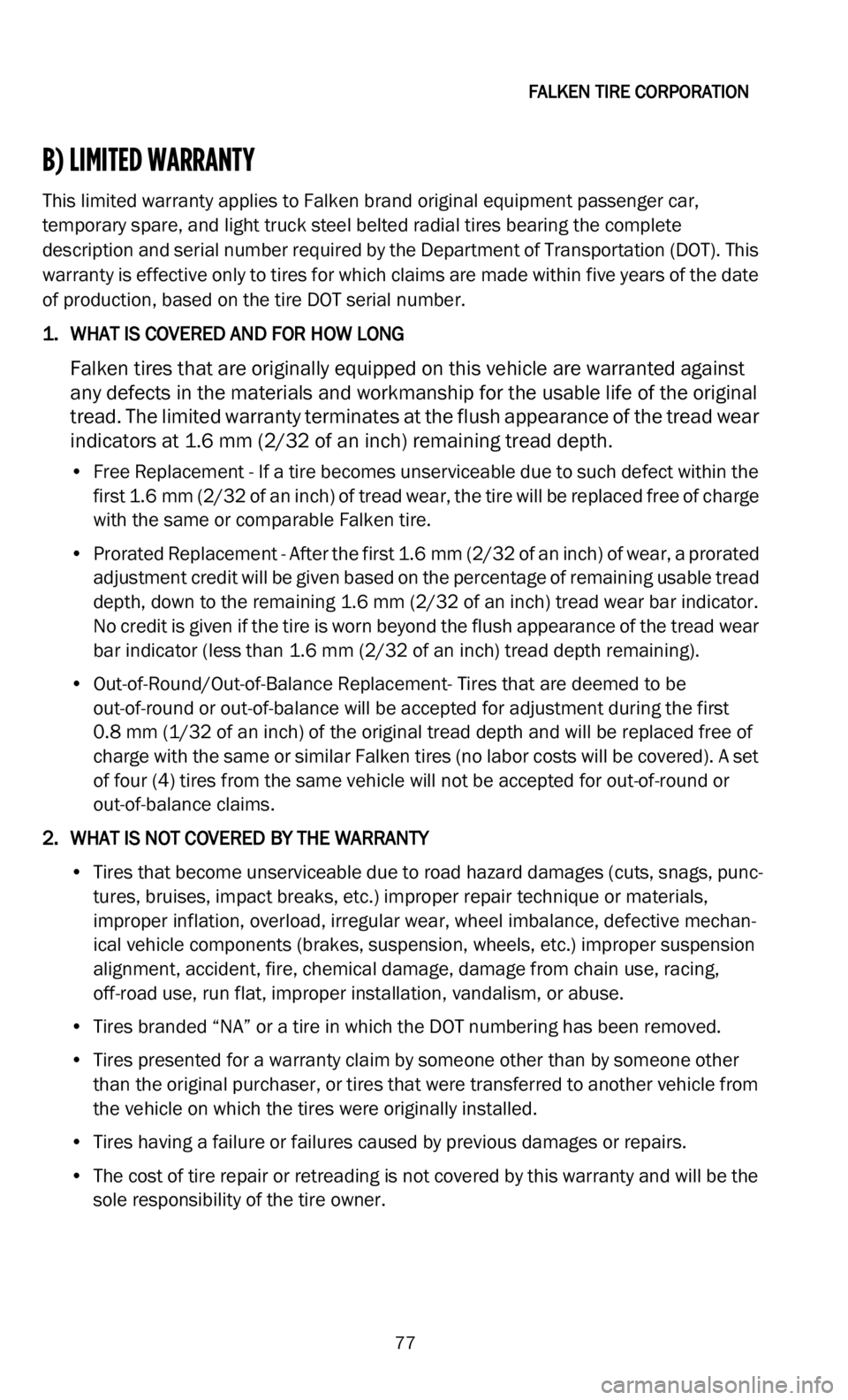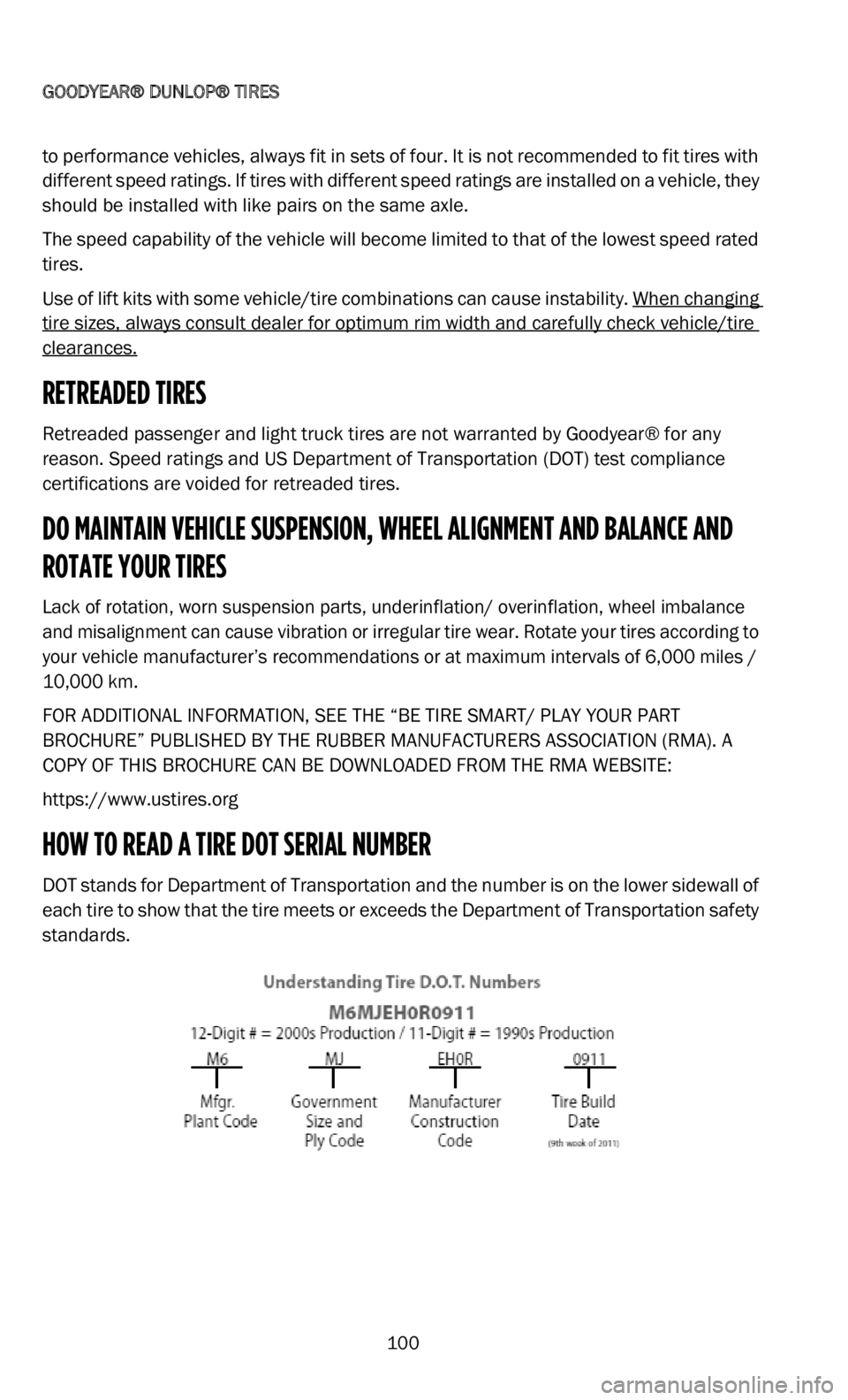air suspension DODGE CHALLENGER 2022 Vehicle Warranty
[x] Cancel search | Manufacturer: DODGE, Model Year: 2022, Model line: CHALLENGER, Model: DODGE CHALLENGER 2022Pages: 200, PDF Size: 6.72 MB
Page 31 of 200

BFGOODRICH® TIRES
30
REPLACEMENT OF TWO TIRES
It is recommended that all four tires are replaced at the same time. However, whenever
on
ly two tires are replaced, the new ones should be put on the rear. The new tires, with
deeper tread, may provide better grip and water evacuation in wet driving conditions.
CUSTOMIZATION OF TIRES, WHEELS, OR SUSPENSION ON SUVS AND LIGHT
TRUCKS
Due to their size, weight and higher center of gravity, vehicles such as SUVs and light
trucks do not
have the same handling characteristics as automobiles. Because of these
differing characteristics, failure to operate your SUV/truck in a proper and safe manner
can increase the likelihood of vehicle rollover. Modifications to your SUV/truck tire size,
tire type, wheels or suspension can change its handling characteristics and further
increase the likelihood of vehicle rollover. Whether your SUV/truck has the original
equipment configuration for tires, wheels and suspension or whether any of these items
have been modified, always drive safely, avoid sudden, sharp turns or lane changes and
obey all traffic laws. Failure to do so may result in loss of vehicle control leading to an
accident and serious injury or death.
TIRE ALTERATIONS
Do not make or allow to be made any alterations on your tires. Alterations may prevent
p r
oper performance, leading to tire damage which can result in an accident. Tires which
become unserviceable due to alterations such as trueing, whitewall inlays, addition of
balancing or sealant liquids, or the use of tire dressing containing petroleum distillates
are excluded from warranty coverage.
REPAIRS - WHEREVER POSSIBLE, SEE YOUR BFGOODRICH® TIRE RETAILER AT ONCE
If any BFGoodrich® tire sustains a puncture, have the tire demounted and thoroughly
i n
spected by any BFGoodrich® tire retailer for possible damage that may have occurred.
A tread area puncture in any BFGoodrich® passenger or light truck tire can be repaired
p r
ovided that the puncture hole is not more than 1/4 of an inch in diameter, not more
than one radial cable per casing ply is damaged, and the tire has not been damaged
further by the puncturing object or by running underinflated. Tire punctures consistent
with these guidelines can be repaired by following the Rubber Manufacturers Association
(RMA) recommended repair procedures.
TIRE REPAIRS
Repairs of all tires must be of the combined plug and inside patch type. Plug only repairs
are improper. A tire should be removed from the rim and inspected prior to repair. Any
tire repair done without removing the tire from the rim is improper. An improperly
repaired tire will cause further damage to the tire by either leaking air or allowing air,
moisture and contaminants to enter the structure of the tire. An improperly repaired tire
can fail suddenly at a later date.
Never repair a tire with less than 2/32 of an inch tread remaining. At this tread depth,
t h
e tire is worn out and must be replaced.
Page 78 of 200

FALKEN TIRE CORPORATION
77
B) LIMITED WARRANTY
This limited warranty applies to Falken brand original equipment passenger car,
temporary spare, and light truck steel belted radial tires bearing the complete
description and serial number required by the Department of Transportation (DOT). This
warranty is effective only to tires for which claims are made within five years of the date
of production, based on the tire DOT serial number.
1. WHAT IS COVERED AND FOR HOW LONG
Falken tires that are originally equipped on this vehicle are warranted against
any defects in the materials and workmanship for the usable life of the original
tread. The limited warranty terminates at the flush appearance of the tread wear
indicators at 1.6 mm (2/32 of an inch) remaining tread depth.
• Free Replacement - If a tire becomes unserviceable due to such defect within the
first 1.6 mm (2/32 of an inch) of tread wear, the tire will be replaced free of charge
w i
th the same or comparable Falken tire.
• P rorated Replacement - After the first 1.6
mm (2/32 of an inch) of wear, a prorated
ad
justment credit will be given based on the percentage of remaining usable tread
depth, down to the remaining 1.6 mm (2/32 of an inch) tread wear bar indicator.
N o
credit is given if the tire is worn beyond the flush appearance of the tread wear
bar indicator (less than 1.6 mm (2/32 of an inch) tread depth remaining).
• O ut-of-Round/Out-of-Balance Replacement- Tires that are deemed to be
o
ut-of-round or out-of-balance will be accepted for adjustment during the first
0.8 mm (1/32 of an inch) of the original tread depth and will be replaced free of
c h
arge with the same or similar Falken tires (no labor costs will be covered). A set
of four (4) tires from the same vehicle will not be accepted for out-of-round or
out-of-balance claims.
2. W HAT IS NOT COVERED BY THE WARRANTY
•
Tires that become unserviceable due to road hazard damages (cuts, snags, punc -
t
ures, bruises, impact breaks, etc.) improper repair technique or materials,
i m
proper inflation, overload, irregular wear, wheel imbalance, defective mechan -
ical vehicle components (brakes, suspension, wheels, etc.) improper suspension
a l
ignment, accident, fire, chemical damage, damage from chain use, racing,
off-road use, run flat, improper installation, vandalism, or abuse.
• T ires branded “NA” or a tire in which the DOT numbering has been removed.
•
Tires presented for a warranty claim by someone other than by someone other
t
han the original purchaser, or tires that were transferred to another vehicle from
the vehicle on which the tires were originally installed.
• T ires having a failure or failures caused by previous damages or repairs.
•
The cost of tire repair or retreading is not covered by this warranty and will be the
s
ole responsibility of the tire owner.
Page 101 of 200

GOODYEAR® DUNLOP® TIRES
100
to performance vehicles, always fit in sets of four. It is not recommended to fit tires with
different speed ratings. If tires with different speed ratings are installed on a vehicle, they
should be installed with like pairs on the same axle.
The speed capability of the vehicle will become limited to that of the lowest speed rated
ti
res.
Use of lift kits with some vehicle/tire combinations can cause instability. When changing
tire sizes, always consult dealer for optimum rim width and carefully check vehicle/tire
clearances.
RETREADED TIRES
Retreaded passenger and light truck tires are not warranted by Goodyear® for any
reason. Speed ratings and US Department of Transportation (DOT) test compliance
certifications are voided for retreaded tires.
DO MAINTAIN VEHICLE SUSPENSION, WHEEL ALIGNMENT AND BALANCE AND
ROTATE YOUR TIRES
Lack of rotation, worn suspension parts, underinflation/ overinflation, wheel imbalance
and misalignment can cause vibration or irregular tire wear. Rotate your tires according to
your vehicle manufacturer’s recommendations or at maximum intervals of 6,000
miles /
1 0
,000 km.
FOR ADDITIONAL INFORMATION, SEE THE “BE TIRE SMART/ PLAY YOUR PART
B R
OCHURE” PUBLISHED BY THE RUBBER MANUFACTURERS ASSOCIATION (RMA). A
COPY OF THIS BROCHURE CAN BE DOWNLOADED FROM THE RMA WEBSITE:
https://www.ustires.org
HOW TO READ A TIRE DOT SERIAL NUMBER
DOT stands for Department of Transportation and the number is on the lower sidewall of
each tire to show that the tire meets or exceeds the Department of Transportation safety
standards.
Page 112 of 200

KUMHO TIRES
111
4. The cost of applicable taxes and mounting and balancing and any other service charges.
5. T ire damage or irregular wear due to:
•
Road hazard, including puncture, cut, impact break, bulge, snag, stone drill, colli -
s
ion.
• C ontinued use while run flat or under acute underinflation.
•
Improper use or operation, without limitation, improper inflation pressure, over -
l
oading, use of an improper rim, tire/wheel assembly imbalance or other vehicle
c o
ndition, worn suspension components, improper mounting or de-mounting,
misuse, misapplication, fire or other externally generated heat, water or other
material trapped inside the tire during mounting, tire alteration, racing or compe -
tition purposes, improper inserting of sealant, balance or filler materials.
• Improper repair, or with repairs not conforming to the Rubber Manufacturers Asso -
c
iation standards, or with section repairs, or with self-vulcanizing plug only.
• F ailure to rotate the tire at least every 5,000 m
iles (8,047 km) as evidenced by
Ku
mho’s Mileage Warranty/Tire Rotation Card (printed in this brochure) or vehicle
misalignment.
• U neven or rapid wear which is caused by mechanical irregularity in the vehicle
s
uch as misalignment, (a measured tread difference of 2/32 of an inch or more
across the tread on the same tire).
6. O zone or weather cracking on tires over four (4) years from the date of manufacture.
7
. T ires that have been recapped, or retreaded, regrooved.
8
. R ide disturbance (out-of-round, vibration, pulling, etc.) claims submitted after the first
2
/32 of an inch of tread wear.
9. Lo ss of time, or use, inconvenience, or any incidental or consequential damage.
1
0.T ires that have been modified by the addition or removal of material or any tire inten -
t
ionally altered to change its appearance.
11.T ires unserviceability caused by the tire operation in excess of tire/wheel manufac -
t
urers specifications and recommendations.
12.T ires that are misapplied due to insufficient speed rating, or undersized, or oversized
t
ires.
13.T ires that have become unserviceable because chemical corrosion, vandalism,
c
hains and flat spotting.
14.T ires involved in any racing-related activities.
1
5.T his limited warranty applies only to the original purchaser and is nontransferable.
Page 134 of 200

MICHELIN®
133
Full-size Spare
Full-size spare tires (not temporary spares) of the same size and construction should be
u s
ed in a five tire rotation. Always check the inflation pressure of the full-size spare
immediately before incorporating it into rotation. Follow the vehicle manufacturer’s
recommended pattern for rotation, or if not available, see a qualified tire technician.
Replacement of Two Tires
It is recommended that all four tires are replaced at the same time. However, when only
t w
o tires are replaced, the new tires should be put on the rear. The new tires, with deeper
tread, may provide better grip and water evacuation in wet driving conditions.
CUSTOMIZATION OF TIRES, WHEELS, OR SUSPENSION ON SUVS AND LIGHT
TRUCKS
Due to their size, weight and higher center of gravity, vehicles such as SUVs and light
trucks do not have the same handling characteristics as automobiles. Because of these
differing characteristics, failure to operate your SUV/truck in a proper and safe manner
can increase the likelihood of vehicle rollover. Modifications to your SUV/truck tire size,
tire type, wheels or suspension can change its handling characteristics and further
increase the likelihood of vehicle rollover. Whether your SUV/truck has the original
equipment configuration for tires, wheels and suspension or whether any of these items
have been modified, always drive safely, avoid sudden, sharp turns or lane changes and
obey all traffic laws. Failure to do so may result in loss of vehicle control leading to an
accident and serious injury or death.
TIRE ALTERATIONS
Do not make or allow to be made any alterations on your tires. Alterations may prevent
proper performance, leading to tire damage which can result in an accident. Tires which
become unserviceable due to alterations such as truing, whitewall inlays, addition of
balancing or sealant liquids, or the use of tire dressing containing petroleum distillates
are excluded from warranty coverage.
REPAIRS WHEREVER POSSIBLE, SEE YOUR MICHELIN® TIRE RETAILER AT ONCE
If any MICHELIN® tire sustains a puncture, have the tire demounted and thoroughly
inspected by any MICHELIN® tire retailer for possible damage that may have occurred.
A tread area puncture in any MICHELIN® passenger or light truck tire can be repaired
provided that the puncture hole is not more than 1/4 inch in diameter, not more than
o n
e radial cable per casing ply is damaged, and the tire has not been damaged further
by the puncturing object or by running underinflated. Tire punctures consistent with
these guidelines can be repaired by following the US Tire Manufacturers Association
(USTMA) recommended repair procedures.
TIRE REPAIRS
Repairs of all tires must be of the combined plug and inside patch type. Your MICHELIN®
PAX® System tires must be removed from the wheel for inspection prior to repair. Plug
only repairs are improper. A tire should be removed from the rim and inspected prior to
Page 179 of 200

TOYO TIRES® – LIMITED WARRANTY
178
REPLACING TWO TIRES
• When a pair of replacement tires is selected in the same size and construction as those on the vehicle, the two newer tires must be installed on the rear axle and must
be of equal or higher speed rating than the front tires. Generally, new tires with deeper
tread will provide better grip and evacuate water more effectively, which is important
as a driver approaches hydroplaning situations. Placing greater traction on the rear
axle on wet surfaces is necessary to prevent a possible oversteer condition and loss
of vehicle stability.
• W hen two new tires have been installed onto the rear axle positions, they are to be
k
ept on the rear but rotated from side to side. This is recommended after installing two
new tires to the rear position, or if you discover significant tread depth differences
between the front and rear positions during rotation intervals.
REPLACING ONE TIRE
• Replacing a single tire on a vehicle can have an adverse effect on suspension systems, gear ratios, transmission, and tire treadwear.
• I f single tire replacement is unavoidable, it is recommended that the single new tire
b
e paired with the tire that has the deepest tread and both be placed on the rear axle.
Placing greater traction on the rear axle on wet surfaces is necessary to prevent a
possible oversteer condition and loss of vehicle stability.
WHEEL ALIGNMENT AND BALANCING
• Proper wheel alignment and balance are very important considerations for safety and getting the maximum mileage from your tires. You need to check how your tires are
wearing at least once a month.
• Y our vehicle may be out of alignment if your tires are wearing unevenly, such as when
t
he inside shoulder of the tire is wearing faster than the rest of the tread. This condi -
tion not only shortens the life of your tires, it adversely affects the handling character -
istics of your vehicle, which could be dangerous. If your tires show irregular wear, have
y o
ur vehicle’s alignment checked immediately.
CAUTION!
In some cases, the vehicle manufacturer may specifically advise against replacing
fewer than all four tires. Always check and follow the recommendations in the vehicle
Owner’s Manual. For 4WD and AWD vehicles, even small differences in outside
diameter may cause drivetrain damage or mechanical malfunction.